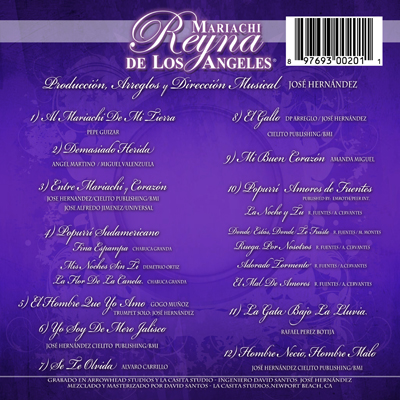Mariachi Reyna de Los Ángeles, America’s pioneer all-female mariachi show group, recently announced the upcoming release of its forth CD, Entre Mariachi y Corazón. Mariachimusic.com spoke with the group’s founder and three of its members about this new album, and the nature and trajectory of this trailblazing mariachi femenil.
Mariachi Reyna de Los Ángeles was founded in 1994 by José Hernández, director of both the Southern California-based Mariachi Sol de México, and the Mariachi Heritage Society, a non-profit organization that provides free or low-cost instruction in mariachi music. Mariachi Reyna derives its name from El Pueblo de Nuestra Señora, la Reina de los Ángeles (The Town of Our Lady, Queen of the Angels)—the 1781 Spanish settlement that later became Los Angeles, California.
All-female mariachi groups have existed in Mexico since the 1940s. The earliest ensemble of this type known to exist in the US was Las Rancheritas, formed in Alamo, Texas in the mid-1960s. It wasn’t until the late 1970s that the next mariachis femeninos appeared in the US. One was Los Angeles-based Las Generalas, a group led by María Elena Muñoz, comadre of José Hernández’s father, Esteban. In the Midwest, Mariachi Estrella de Topeka (Kansas), was formed in 1977, but disbanded in 1981 after four of the women perished in a tragic accident. From then until the time Reyna de Los Ángeles was formed in 1994, there were no visible all-female mariachi groups in the United States, although numerous individual female mariachi musicians were active in this country from the early 1970s onward.
José Hernández recalls how, after watching a performance by a Mexican mariachi femenino of modest musicianship, he came up with the idea of forming a truly professional all-female ensemble. “I wanted to start a group that would inspire male musicians to say, ‘Wow! This group deserves our musical respect!’ I wanted a mariachi in which the women were interested in playing well, not just settling for applause because of their gender, and I knew there was a lot of female mariachi talent out there. From the very beginning, the members of Reyna wanted to be known first and foremost for their musicianship and tight ensemble playing, and they were willing to do the necessary work to accomplish this. That’s what this group has always been about.”
Hernández believes that Mariachi Reyna came along at just the right time. By 1994, female enrollment in mariachi workshops and educational programs had become so high that the girls often outnumbered the boys. “The boom that began with Linda Ronstadt was still in vogue, and the group was accepted immediately,” he comments. Reyna de Los Ángeles was founded in January of that year, and their first important concert was the following June, at Mariachi USA. They eventually performed on the Don Francisco show and got a contract with Universal Records. “I believe Reyna was the first all-female mariachi to hit big on the national scene, and they’ve motivated a lot of young girls to become mariachi musicians, especially our students at the Heritage Society’s school,” says Hernández. In 2008, PBS debuted Compañeras, a feature documentary on the group.
Julie Murillo has been leader of Mariachi Reyna since 2007. When asked about her duties in this role, she replied: “As part of my responsibilities, I’m required to schedule rehearsals, be in constant communication with these ladies for upcoming events, make sure suits are maintained, etc. I believe that the key to a successful, well-organized group is communication and respect. You need to be able to acknowledge that everyone plays an important role, and that each one of your members’ strengths helps keep it together.” Previous leaders were Laura Gariacano Sobrino (1994-96), Cindy Reifler (1996-2003), Cathy Marín (2003-2005), and Sylvia Hinojosa (2005-2007).
Although Reyna isn’t a full-time group like Mariachi Sol de México, its demanding rehearsal and performance schedule requires a serious commitment on the part of its members, most of whom are Mexican American and in their twenties or thirties. All of them have other occupations, and the overwhelming majority are college graduates. Sarah Bauza is finishing up her doctorate in trumpet performance at USC Thornton School of Music. Vanessa Sánchez is an ethnomusicology graduate from UCLA.
Charter member Sylvia Hinojosa, who began her musical career as a young student at the Mariachi Heritage Society, describes Mariachi Reyna’s role in her life: “We are not a full time mariachi like José’s all-male group, and honestly, we prefer it this way. You see, although we admire and respect what the guys do, we have different priorities, and I think it’s just a girl thing. We feel like we have to spread out our time evenly among all our tasks—school, children, profession, music, etc. In my case, I like to have Reyna as a very disciplined ‘hobby.’ I don’t want to see it as a job, but rather as an escape from a routine, or a wonderful tool to express and let out any hidden emotions. These ladies are amazing, talented musicians whom I admire and feel very blessed to call my compañeras.”
Sylvia’s compañera Vanessa Sánchez adds: “We’re happy to make time for the group because our heart is in the music. We strive to play an active role as women in mariachi, because we understand that there are only a handful of role models for female mariachis. For this reason, it’s important that we maintain a high musical standard.”
Mariachi Reyna’s latest CD, Entre Mariachi y Corazón, opens with Pepe Guízar’s classic “Al Mariachi de mi Tierra.” The album’s title song is a huapango-corrido coauthored by José Alfredo Jiménez, Jr. and José Hernández. Other original Hernández arrangements and compositions on this CD include son jalisciensce “Yo Soy de Mero Jalisco,” huapango “Hombre Necio, Hombre Malo,” and son huasteco “El Gallo.” The album’s only bolero is Álvaro Carrillo’s classic “Se te Olvida,” a song that will forever be associated with Javier Solís. Two popurrís are featured –“Popurrí Sudamericano” is a medley of three Peruvian classics, while “Popurrí Amores de Fuentes” features five of the Rubén Fuentes huapangos that caused a virtual revolution in mariachi music during the 1950s.
Four hit baladas complement the more traditional mariachi songs on this CD—Miriam Hernández’s “El Hombre Que Yo Amo,” Rocío Dúrcal’s “La Gata Bajo la Lluvia,” Paloma San Basilio’s “Demasiado Herida,” and Amanda Miguel’s “Mi Buen Corazón.” “Today’s mariachi is capable of playing this kind of music, and the public has come to expect it, so why not?” asks Hernández. At the same time, he explains, Mariachi Reyna has always been very careful not to stray too far from mariachi music’s traditional roots.
When asked about the difference between the arrangements he writes for Sol de México and those he writes for Reyna, José replied, “I don’t simplify my arrangements because they’re written for female musicians. I write at the same level of technical difficulty for them as I would for Sol de México, or for any other professional group. For that reason, the girls have to practice and rehearse a lot. Reyna plays all original arrangements, written especially for their group, in the appropriate keys for their voices. It’s my job as composer and arranger to make sure their vocal color shines in all its splendor.”
Asked whether the group uses written music for their recording sessions, José responded, “Only as a rough guide. I don’t want my musicians sight-reading in the studio. I want them to come to the recordings with the music well-rehearsed and, if possible, memorized, so they can put all their attention into interpretation. El fraseo que se usa en el mariachi no es un fraseo leído. It’s rubato, like that of a solo singer. Unless you’re very experienced, depending on written music can make your interpretation mechanical, and that’s definitely not what we want.”
Since its inception, Reyna has been a fixture on the US mariachi festival circuit. Lately, the group has been touring even more extensively, both on its own and with Mariachi Sol de México. In April and May, they’ll perform in Monterey, CA and in New Jersey; in June, they’ll be among the headliners at the Mariachi USA festival in Los Angeles; in July, they’ll be appearing at the Montana Folk Festival; in August, they’ll celebrate the group’s 20th anniversary at the José Hernández Mariachi Nationals in Orange, CA.
The CD release party for Entre Mariachi y Corazón is scheduled for May 7th at Cielito Lindo Restaurant, in El Monte, California. Beginning on that date, the compact disc will be available for purchase from popular Internet sources, reynadelosangelesmusic.com, or iTunes. For a sample of this upcoming release, you can hear Vanessa Sánchez sing “El Hombre Que Yo Amo,” and Julie Murillo sing “Al Mariachi de mi Tierra,” on YouTube.
“This CD is a testament to the group’s hard work and to staying true to the mariachi genre,” says José Hernández. “That’s what Mariachi Reyna stands for, and that’s what this album is all about.”
Mariachi Reyna de Los Ángeles
- Sarah Bauza (trumpet)
- Alina Estrada (violin)
- Luisa Fregoso (violin)
- Angélica Hernández (guitar)
- Sylvia Hinojosa (violin)
- Jeanette Martínez (vihuela)
- Julissa Murillo (violin, director)
- Laura Peña (violin)
- Vanessa Sánchez (violin)
- Karla Tovar (guitarrón)
- Linda Uhila (trumpet)







